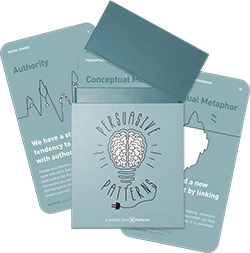Limited Choice
Design Pattern
Problem summary
We are more likely to make a decision when there are fewer options to choose from
Usage
- Use when you want to ensure that users make a choice, now
- Use to push users through a tunnel or funnel
- Use when you want to reduce the complexity of your interface
This card is part of the Persuasive Patterns printed card deck
The Persuasive Patterns Card Deck is a collection of 60 design patterns driven by psychology, presented in a manner easily referenced and used as a brainstorming tool.
Get your deck!Solution
How many choices do you offer? Can this be reduced? Every time you make it easier for users to think, they are more likely to make a decision.
Simplify decision paths and present the more complex choices first.
- Reduce choices available. How many choices do you offer? Can this be reduced? Every time you make it easier for users to think, they are more likely to make a decision.
- Find the right amount of choices. At first, more choices lead to more satisfaction, but as number of choices increases, satisfaction peaks whereafter people tend to feel more pressure, confusion, and dissatisfaction with their choice.
- Avoid analysis paralysis. When confronted with too many choices especially under a time constraint, many people prefer to make no choice at all, even if making a choice would lead to a better outcome.
Rationale
Making a decision becomes overwhelming when we aare faced with many options due to the many potential outcomes and risks that may result from making the wrong choice. Having too many approximately equally good options is mentally draining. Although larger choice sets can be initially appealing, smaller choice sets lead to increased satisfaction and reduced regret.
One of the central contributions of cognitive psychology has been to explore limitations in the human capacity to store and process information. Ou ability to pursue multiple intentional goals at any one time is thought to be restricted by a limited budget of strategic processing capacity
This pattern talks to the core foundation of cognitive psychology: we have a limited processing capacity.
1 Hertwig & Todd (2003). More Is Not Always Better: The Benefits of Cognitive Limits, Thinking: Psychological Perspectives on Reasoning, Judgment and Decision Making, Chapter 11, John Wiley & Sons
2 Iyengar & Lepper (2000). When choice is demotivating: Can one desire too much of a good thing?, Journal of Personality and Social Psychology. 79 (6): 995–1006
3 The Psychology of Choice by Liraz Margalit
4 Limited Choice at Learning Loop
User Interface Design Patterns
- Forms
- Explaining the process
- Community driven
- Tabs
- Jumping in hierarchy
- Menus
- Content
- Gestures
- Tables
- Formatting data
- Images
- Search
- Reputation
- Social interactions
- Shopping
- Increasing frequency
- Guidance
- Registration
Persuasive Design Patterns
- Loss Aversion
- Other cognitive biases
- Scarcity
- Gameplay design
- Fundamentals of rewards
- Gameplay rewards


